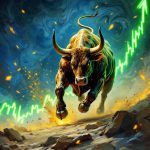
What Type of Trader Am I?
Apr 3, 2025
Who are you when the market roars or crumbles? Are you the unflinching tactician, calmly striking when opportunity arises? Or do you find yourself paralysed by fear, chasing the crowd and hoping for security? To trade is to engage in a battle—not only with the market but with yourself. It is a test of discipline, psychology, and strategy. And yet, the success of any trader hinges on the ability to answer a deceptively simple question: what type of trader am I?
Understanding your trading style is not merely a matter of preference; it is a reflection of your psychological makeup, risk tolerance, and decision-making under pressure. It requires an unflinching examination of your strengths, weaknesses, and emotional tendencies. The truth is that trading is not a one-size-fits-all endeavour. From the methodical swing trader to the lightning-fast scalper, every style requires specific skills, strategies, and mindsets. This essay will help you uncover what drives your trading decisions, how to align your strategy with your psychology, and how to move beyond the traps of herd behaviour to find clarity in chaos.
The Psychology of Trading: Knowing Yourself
Before you can determine your trading style, you must first understand the psychological forces that shape your decisions. Trading is not purely a game of numbers; it is a psychological battlefield where fear and greed reign supreme. These emotions, deeply ingrained in human nature, drive the majority of traders to make irrational decisions—buying when they should sell, holding when they should exit, or following the herd into overbought markets.
One of the most pervasive psychological biases in trading is loss aversion—the tendency to fear losses more than we value equivalent gains. This bias often leads traders to hold onto losing positions for too long, hoping the market will “turn around,” even when all indicators suggest otherwise. Similarly, confirmation bias drives traders to seek out information that supports their pre-existing beliefs, ignoring evidence that contradicts their positions. These biases cloud judgment and prevent traders from acting rationally.
Herd mentality is another powerful force in trading. When markets rally, it feels almost impossible to resist the pull of FOMO (fear of missing out). Traders pile into positions because “everyone else is doing it,” only to be caught on the wrong side of a correction. Conversely, during market crashes, the same herd behaviour drives panic selling, exacerbating losses.
As Marcus Aurelius, the Stoic philosopher and Roman emperor, once wrote, “You have power over your mind—not outside events. Realise this, and you will find strength.” To succeed as a trader, you must develop this mental clarity. It begins with understanding your psychological tendencies and how they align with specific trading styles.
Identifying Your Trading Style: The Key to Consistency
There are as many trading styles as there are traders, but most fall into a few broad categories. Each style requires a specific mindset and skill set. By understanding these categories, you can find the one that best aligns with your personality and goals.
1. The Day Trader: Do you thrive on adrenaline and fast decision-making? Day traders execute multiple trades within a single day, taking advantage of short-term price movements. This style demands intense focus, quick reflexes, and the ability to remain unemotional under pressure. It is ideal for those who thrive in high-energy environments and can commit to constant monitoring of the markets. However, it is not for the faint of heart; the fast-paced nature of day trading can amplify emotional biases, leading to impulsive decisions.
2. The Swing Trader: If you prefer a more methodical approach, swing trading may be your style. Swing traders hold positions for several days or weeks, aiming to capture medium-term trends. This style requires patience, technical analysis skills, and the ability to tolerate moderate risk. Swing traders are less affected by the day-to-day noise of the market, allowing them to make more calculated decisions. However, they must be cautious of overconfidence and the temptation to “overtrade” during periods of market stagnation.
3. The Position Trader: Position traders take a long-term view, holding positions for months or even years. This style is ideal for those who prioritise fundamental analysis and are willing to ride out short-term volatility in pursuit of larger gains. Position traders are less susceptible to emotional decision-making, as they are focused on the bigger picture. However, this style demands discipline and the ability to resist the urge to react to short-term market movements.
4. The Scalper: Scalping is the art of making numerous small trades within minutes or seconds, capturing tiny price movements. It requires lightning-fast reflexes, technical precision, and a high tolerance for stress. Scalpers must remain hyper-focused and unemotional, as even a momentary lapse in judgment can result in losses. This style is best suited for traders who thrive on speed and precision but can be overwhelming for those who struggle with high-pressure situations.
Each style has its own strengths and weaknesses, and choosing the right one depends on your personality, goals, and risk tolerance. The key is to align your trading style with your natural tendencies rather than forcing yourself into a mould that doesn’t fit.
Beyond the Herd: Escaping Fear-Driven Behaviour
Regardless of your trading style, success requires breaking free from the herd mentality that dominates the markets. The greatest traders in history—from Jesse Livermore to George Soros—have one thing in common: they think independently. They do not follow the crowd; they lead it. To achieve this level of clarity, you must cultivate a contrarian mindset and develop the discipline to act rationally when others are driven by fear or greed.
One of the most effective ways to escape herd behaviour is to focus on process over outcome. Too many traders judge their success by the profitability of individual trades, rather than the consistency of their strategy. This short-term focus leads to emotional decision-making and reactive behaviour. By prioritising a disciplined, repeatable process, you can maintain clarity and consistency, even in volatile markets.
Another key strategy is to use risk management as a tool for emotional control. Setting clear stop-loss levels, position sizes, and profit targets allows you to trade with confidence, knowing that your downside is limited. This reduces the temptation to panic or second-guess your decisions when emotions run high.
Finally, embrace the wisdom of the Stoics. As Seneca wrote, “Luck is what happens when preparation meets opportunity.” The best traders are those who prepare relentlessly, study the markets, and act decisively when opportunities arise. They do not rely on luck; they create it through discipline and focus.
Practical Steps to Define Your Trading Identity
To answer the question, “What type of trader am I?” you must engage in honest self-reflection and take practical steps to align your trading style with your goals. Here are three actionable steps to help you on your journey:
1. Assess Your Risk Tolerance: Are you comfortable with high levels of risk, or do you prefer a more conservative approach? Your risk tolerance will determine which trading style is most suitable for you. For example, day traders and scalpers must be willing to accept frequent small losses, while position traders can tolerate larger drawdowns in pursuit of long-term gains.
2. Experiment with Different Styles: If you’re unsure which style suits you, start with a demo account and experiment with different approaches. Track your performance and assess how each style aligns with your personality and decision-making tendencies.
3. Develop a Trading Plan: Once you’ve identified your trading style, create a detailed plan that outlines your strategy, risk management rules, and goals. This plan will serve as your roadmap, keeping you focused and disciplined, even when emotions threaten to take over.
Conclusion: Mastering the Art of Trading
The question “What type of trader am I?” is not just about strategy; it is about self-awareness. It is an invitation to examine your psychology, understand your strengths and weaknesses, and align your trading approach with your unique temperament. Whether you are a methodical swing trader, a high-energy scalper, or a patient position trader, the key to success lies in knowing yourself and remaining disciplined in the face of market uncertainty.
As you embark on your trading journey, remember the timeless wisdom of Marcus Aurelius: “You have power over your mind—not outside events. Realise this, and you will find strength.” By mastering your psychology, embracing independent thinking, and developing a disciplined process, you can navigate the complexities of the market with confidence and clarity, transforming challenges into opportunities and unlocking your full potential as a trader.












